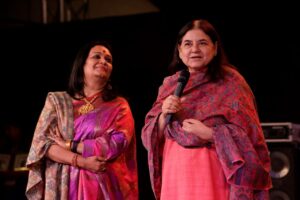There are some art festivals in India that are iconic and every artist looks forward to being a part of it either as a participant or as an audience. The Delhi International Art Festival (DIAF) is one for sure that everyone awaits eagerly. For the last few years due to Covid the festival did not take place and finally it did come back for the art lovers and what a splash it made, that it mesmerised one and all. I spoke with the very elated festival curator and director Padma Shri Prathibha Prahlad and this is what she said, excerpts from the interview:
Back with a bang, after covid, how do you feel?
This year’s Delhi International Arts Festival was nothing short of magic. It had divine blessings. Though talks were on about getting the Festival back since April 2022, things were not definite and funding was in huge doubt. It was only in November that we got a go-ahead for the Festival. I was overjoyed and I am glad it all fell into place and we could get DIAF to the audience. I am glad Minister of State for External Affairs Meenakshi Lekhi and Maneka Gandhi came to support us along with many others.

DIAF Festival Curator and Director Padma Shri Prathibha Prahlad with Maneka Gandhi (left)
and Minister of State for External Affairs Meenakshi Lekhi (right)
I believe DIAF had interesting themes this year, please explain?
Yes, the festival this year was thematic with the three broad themes a) our epics and cultural treasures b) unsung heroes and heroines of the freedom struggle c) policies of the current Govt. that effect change in environment and ecology, not polluting the rivers, nurturing the girl child, and such like.
The venue was magical isn’t it?
When Kartavya Path was decided as the main venue, the excitement was palpable. We never knew how challenging it was going to be or how expensive it would be to mount a huge festival for full 15 days in the two open air amphi-heatres of Kartavya Path. There was only one thought on my mind. DIAF had reached India Gate and we had to do the best possible with the very meagre funds we had to ensure that our arts and our cultural legacy got a pride of place in our polity and engaged, educated and entertained the masses and those not exposed to our arts in a meaningful manner. I think we accomplished this because we had overflowing audiences every single evening and people seemed to thrilled that DIAF exposed to them to our invaluable artistic wealth.
During Covid, many festivals went online but you choose not to, why?
I believe that performing arts have to have to be live and have a live audience for lasting impact. Editing videos, putting out 2-10 minute pieces online, trying to get maximum viewership and likes, fabricating numbers, pretending that online presence and number of likes was actual and real is all a mis-representation and a lie. To me, DIAF is a passion to engage and educate people about the depth, diversity and the invaluable wealth of India’s intangible heritage- not just a festival to earn money. I detest online dance videos and did not involve myself in anything to do with it – be they my own performances or festivals.
As always DIAF rocked, which was the most favourite part of the show for you?
The Festival really did Rock and How!!! Like I mentioned, the engagement was phenomenal, the whole place looked like paradise and I kept looking at our stage and backdrop and thinking the stars were dropping down from Heaven. There were many extraordinary performances, but my productions Walking with the Mahatma and Warrior Women of Bharat were truly special and got huge standing ovations.
What was the highlight of this year’s show?
There were exceptional productions based on epics-like Jaya Ram by Sutra Dance Company and Sri Ramayan by Pavitra Bhatt, Rasa United’s Trayambakam, Prasiddha Repertory’s Ekam Sat, Kathastra by Prabhat Group, theatrical productions like Veer Abhimanyu, Chavundaraya, Bacchi, productions on India’s Freedom Struggle like Warrior Women of Bharat, Samarpan by Pulakeshi Kasturi’s group, Rudramma by Alekhya Punjala’s group etc., productions on environment & water preservation like A drop to the Ocean by Meera Das, Earth Diaries by Gauri Diwakar, Rivers to Reverse by Sruti Gopal, Guhya by Poornima Gururaj, productions on the girl child such as Ma Mujhe To Jeene Do by Shovana Narayan’s group, Su-Shakti & others.
How difficult was it to get the show back on ground?
The number one difficulty is adequate funding. While the Government and Corporates spend crores on meaningless festivals with hundreds dancing or other such events, they do not grant adequate funds to a Festival that projects India in a strategic manner and brands it as a cultural super power on the world stage such as DIAF. I cannot understand why, even after 15 years of consistent and top quality work, we should struggle for grants and sponsorships every year. So, every year, it is a huge challenge to match the money we have with the visibility and expectations that people all over the world in culture have of DIAF. The second is a committed and talented office that knows administration of culture. Culture administration is a specialist’s job, not everyone can easily manage that. It has been a real challenge to train people every year. I am praying that our Prime Minister intervenes and sets this right so that there is a course correct in arts administration by the Government machinery.
Sandip Soparrkar holds a doctorate in world mythology folklore from Pacific University USA, an honorary doctorate in performing arts from the National American University. He is a World Book Record holder, a well-known Ballroom dancer and a Bollywood choreographer who has been honored with three National Excellence awards, one National Achievement Award and Dada Saheb Phalke award by the Government of India.
He can be contacted on sandipsoparrkar06@gmail.com